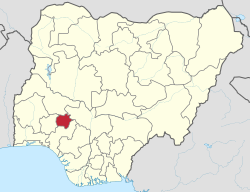INTRODUCTION
Ekiti State is one of the six states that make up the South-West geopolitical zone of Nigeria. It has interstate boundaries with Ondo State to the South, Kwara State to the North, Kogi State to the East and Osun State to the West. The state capital is Ado-Ekiti.
LANDMASS, LOCATION, AND POPULATION
Ekiti State covers an area of 6,353.2 square kilometres. It lies at latitude 7°40′ North and longitude 5°5′ East. It has a population of 2,398,957 (2006 census) 3,270,798 (2016 forecast) with a population density of 377. The state accounts for 1.7% of Nigeria’s total population.
HISTORY AND PEOPLE
The early settlers of Ekiti State were the Yoruba people. Ekiti State was originally part of the Western Region in the three-region structure of 1954. In 1967 with the creation of twelve federal states by General Yakubu Gowon’s military government, Ekiti State became part of Western State.
The military government of General Murtala Muhammed created nineteen states out of the existing twelve in 1976 and Ekiti State was made a component of Ondo State. In 1996, the military government of General Sani Abacha carved out a region (which comprised the twelve Local Government Areas (LGAs) that had made up the Ekiti Zone of Ondo State) to establish Ekiti State. The state derives its name from ’Okiti,’ the local term for hill as its landscape consists of ancient plains broken by steep-sided outcropping dome rocks.
The main ethnic group in Ekiti State is the Yoruba people. Yoruba is the only indigenous language in the state. Christianity and Islam are the main religions in Ekiti State, although traditional religion is also practised there.
MAIN TOWNS AND CITIES
Ado-Ekiti (capital), Aramoko, Efon-Alaaye, Otun, Ijero, Ikere, Ikole, Ise and Ode-Ekiti.
LOCAL GOVERNMENT AREAS
ADMINISTRATORS AND GOVERNORS
Mohammed Bawa (Administrator – Military): October 1996 – August 1998
Atanda Yusuf (Administrator – Military): August 1998 – May 1999
Niyi Adebayo (Governor – Civilian (Alliance for Democracy)): May 1999 – May 2003
Ayo Fayose (Governor – Civilian (People’s Democratic Party)): May 2003 – October 2006
Tunji Olurin (Administrator – Civilian (People’s Democratic Party)): October 2006 – April 2007
Tope Ademiluyi (Acting Governor – Civilian (People’s Democratic Party)): April 2007 – May 2007
Segun Oni (Governor – Civilian (People’s Democratic Party)): May 2007 – Oct 2010
Kayode Fayemi (Governor – Civilian (Action Congress of Nigeria)): October 2010 – October 2014
Ayo Fayose (Governor – Civilian (People’s Democratic Party): October 2014 – October 2018
Kayode Fayemi (Governor - Civilian (All Progressives Congress): October 2018 – Present
ECONOMY AND EDUCATION
Cocoa
Ekiti State is predominantly tropical rainforest with some areas to the north and west being forest savannah. Agriculture is very important in the state, about 75% of its workers engaged in farming. The main cash crops are cocoa, rice, kola nut and oil palm while cassava, yam, cocoyam, corn, cashew, cowpea and plantain are cultivated for domestic consumption.
A significant amount of industrial wood supply for export and the domestic market comes from the state. The major minerals found in Ekiti State include clay, kaolin, columbite and industrial sand. A number of agro-allied and wood processing industries exist in the state.
The tertiary institutions in the state are Federal University of Oye; Federal Polytechnic, Ado Ekiti; Ekiti State University, Ado Ekiti; Afe Babalola University, Ado Ekiti; College of Education, Ikere-Ekiti; Crown Polytechnic, Odo Ekiti; College of Health Sciences and Technology, Ijero-Ekiti and School of Nursing. Ado Ekiti.
FAMOUS SITES AND CULTURE
Sites
Ikogosi Warm and Cold Springs, Ikogosi
Ikogosi springs is a confluence of hot and cold springs in a valley in Ikogosi, Ekiti West local government area. At this site, the two springs meet, maintaining their respective temperature and then flow down as a single stream.
Arinta Waterfalls, Ipole-Iloro
Located in Ipole-Iloro, the Arinta waterfalls has seven cascades. It is surrounded by steep valleys, deciduous trees, bird colonies, rugged hills, a flowing stream, and a huge rock.
Olosunta, Ughele and Orole Hills, Ikere
The steep-sided Olosunta, Ugele and Orole hills are the largest in Ekiti State and in Ikere town. They are regarded as sacred mountains by inhabitants of the town who believe that the Olosunta and Orole deities live there.
Culture
The people of Ekiti State celebrate the Ogun festival in August or September. It is the only festival that brings all the indigenes of the state both at home and in the diaspora together.
The people of Ado Ekiti celebrate the Udiroko or Olorunborun festival to give thanks to God. It marks the first day of the year for inhabitants of the state’s capital.
The Epa festival is an annual cultural event put together by wards in Oke-Ero local government area to pray for good health and great harvest during the planting season.
Other major cultural activities in the state include the Odun Ifa, Epa (masquerade) celebrated by residents of Isan, the Ajagbo Dance and the Okorobo festival.
NOTABLE INDIGENES
Adeyinka Adeyemi (1937-2022)
Adekunle Fajuyi (1926-1966)
DID YOU KNOW
Kunle Olasope, an indigene of Efon Alaaye Ekiti, was the first Nigerian to appear on television in Africa when WNTV (the first television station in Africa) was commissioned in Ibadan in 1959.
EKITI STATE IN PICTURES

